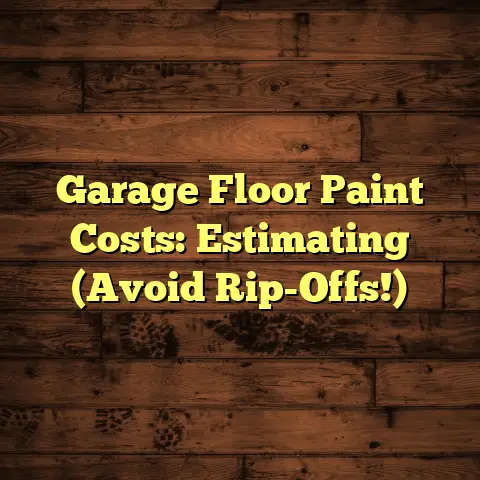Waterproofing Rubber Tiles: Consider This! (3 Key Tips)
Consider This! (3 Key Tips)
Ever thought about what’s lurking beneath your rubber tiles?Did you know that improper waterproofing of rubber tiles can lead to costly damages and health hazards in your space?
It’s a question most people don’t consider until they’re knee-deep in a problem.
I’ve seen firsthand how water damage can wreak havoc, and believe me, it’s not a pretty sight.
Let’s dive into the world of rubber tiles and how to keep them dry and durable!
1. Understanding Rubber Tiles and Their Benefits
So, what exactly are rubber tiles?
Well, they’re typically made from recycled or synthetic rubber, and they come in various forms.
Think interlocking tiles, rolled rubber, and even specialized shapes for different applications.
You’ll often find them in gyms, playgrounds, basements, and even outdoor patios.
Why are they so popular?
For starters, rubber tiles are incredibly durable.
They can withstand heavy foot traffic and impact without showing much wear and tear.
Plus, they offer excellent slip resistance, which is a huge safety benefit, especially in wet areas.
And let’s not forget the comfort factor.
Rubber tiles provide a cushioned surface that’s much easier on your joints than concrete or hardwood.
I remember one client who installed rubber tiles in their home gym.
They raved about how much more comfortable their workouts were!
Because of these benefits, rubber tiles are a great choice for moisture-prone areas.
But here’s the catch: rubber itself isn’t inherently waterproof.
That’s where proper waterproofing comes in.
2. The Importance of Waterproofing
Why is waterproofing so critical?
Imagine this: water seeps through the seams of your rubber tiles and gets trapped underneath.
It creates a breeding ground for mold and mildew.
Not only is that a health hazard, but it can also cause structural damage to the subfloor.
I’ve seen basements where the subfloor was completely rotted out due to unchecked water damage.
It’s a costly and time-consuming repair.
Waterproofing is especially necessary in high-humidity environments like basements or bathrooms.
Also, consider areas with heavy foot traffic where water is frequently tracked in.
Think about entryways or mudrooms.
Without proper waterproofing, your rubber tiles will deteriorate much faster.
You’ll end up replacing them sooner than you should.
Trust me, I’ve seen it happen time and time again.
Waterproofing is an investment that protects your flooring and your health.
It saves you money in the long run.
3. Key Tip #1: Choose the Right
Waterproofing Product
Okay, so you know waterproofing is important.
But how do you choose the right product?
There are several options available, each with its own pros and cons.
-
Sealants: These are typically applied to the seams and edges of the tiles to create a watertight barrier. Silicone-based sealants are a popular choice.
-
Membranes: These are thin, flexible sheets that are installed beneath the tiles to provide a waterproof layer. They’re ideal for areas with high moisture levels.
-
Sprays: These are easy to apply and can cover large areas quickly. However, they may not provide as robust protection as sealants or membranes.
The best choice depends on the type of rubber tile you have and the environment it will be installed in.
For example, if you’re installing interlocking rubber tiles in a basement, a membrane might be the best option.
It provides a continuous waterproof barrier that prevents moisture from seeping through the seams.
If you’re using rolled rubber in a gym, a sealant applied to the edges might be sufficient.
It depends on the level of moisture exposure.
Also, consider eco-friendly options.
There are many waterproofing products that are low in VOCs (volatile organic compounds).
These are better for your health and the environment.
I always recommend looking for products that are certified by reputable organizations like GreenGuard.
Here’s a quick table to illustrate different products and their typical uses:
| Waterproofing Product | Typical Use | Pros | Cons |
|---|---|---|---|
| Silicone Sealant | Seams and edges | Easy to apply, flexible, good for minor moisture | May not be sufficient for high-moisture areas |
| Waterproof Membrane | Underneath tiles | Provides a continuous barrier, excellent for high-moisture areas | More labor-intensive to install |
| Waterproof Spray | Large surface areas | Quick and easy to apply, good for light moisture | May not be as durable as sealants or membranes |
| Eco-Friendly Sealant | General waterproofing | Low VOCs, better for health and environment | May be more expensive than traditional options |
Choosing the right product is the foundation of effective waterproofing.
Don’t skimp on this step!
4. Key Tip #2: Proper Installation Techniques
Even the best waterproofing product won’t work if it’s not installed correctly.
Proper installation is crucial for ensuring effective waterproofing.
Here’s a step-by-step guide to help you get it right:
Step 1: Prepare the Surface
Start by cleaning the subfloor thoroughly.
Remove any dirt, dust, or debris.
I usually recommend using a vacuum cleaner and then wiping the surface with a damp cloth.
Make sure the subfloor is completely dry before proceeding.
Step 2: Apply the Waterproofing Agent
If you’re using a membrane, unroll it and cut it to size.
Apply adhesive to the subfloor and carefully place the membrane on top.
Make sure there are no air bubbles or wrinkles.
If you’re using a sealant, apply it to the seams and edges of the tiles using a caulking gun.
Smooth it out with your finger or a putty knife.
If you’re using a spray, apply it evenly over the entire surface.
Follow the manufacturer’s instructions for drying time.
Step 3: Install the Tiles
Carefully place the rubber tiles on top of the waterproofed surface.
Make sure they’re aligned properly and that there are no gaps.
If you’re using interlocking tiles, snap them together securely.
If you’re using rolled rubber, use adhesive to glue it to the subfloor.
Common Mistakes to Avoid
- Skipping surface preparation: This is a big one. If the subfloor isn’t clean and dry, the waterproofing agent won’t adhere properly.
- Applying too little product: Don’t be stingy with the waterproofing agent. Use enough to create a solid barrier.
- Ignoring drying times: Make sure the waterproofing agent is completely dry before installing the tiles.
- Leaving gaps or seams: These are weak spots that can allow water to seep through.
Here’s a real-life example:
I once had a client who tried to install rubber tiles in their basement without properly preparing the surface.
They ended up with mold growth and had to tear everything out and start over.
It was a costly mistake that could have been avoided with proper installation techniques.
Proper installation is key to preventing water damage and ensuring the longevity of your rubber tiles.
Don’t cut corners!
5. Key Tip #3: Maintenance and Inspection
Waterproofing isn’t a one-time thing.
It requires ongoing maintenance and regular inspections to ensure it remains effective over time.
Think of it like getting your car serviced.
You need to keep up with routine maintenance to keep it running smoothly.
Here’s a checklist for homeowners and facility managers:
- Routine Cleaning: Clean your rubber tiles regularly with a mild soap and water solution. Avoid harsh chemicals or abrasive cleaners.
- Resealing: Depending on the product, you may need to reseal the seams and edges of the tiles every few years.
- Monitoring for Moisture: Keep an eye out for signs of moisture infiltration, such as water stains, mold growth, or a musty odor.
- Check for Damage: Regularly inspect the tiles for cracks, tears, or other damage that could compromise the waterproofing.
The frequency of inspections depends on the usage scenario and environmental conditions.
For example, if you have rubber tiles in a high-traffic area, you’ll need to inspect them more frequently.
If you live in a humid climate, you’ll also need to be more vigilant.
I recommend inspecting your rubber tiles at least once a month.
It only takes a few minutes, and it can save you a lot of headaches down the road.
If you notice any signs of water damage, address it immediately.
Don’t wait until it becomes a bigger problem.
Small leaks can quickly turn into major disasters.
I remember one facility manager who neglected to inspect their rubber flooring regularly.
They ended up with a massive mold infestation that cost them thousands of dollars to remediate.
Regular maintenance and inspection are essential for keeping your rubber tiles waterproof and preventing costly repairs.
Stay vigilant!
Conclusion
So, there you have it!
Waterproofing rubber tiles is crucial for maintaining a safe and resilient flooring solution.
By choosing the right product, using proper installation techniques, and performing regular maintenance, you can protect your investment and prevent costly water damage.
Remember these three key tips:
- Choose the Right Waterproofing Product: Select a product that’s appropriate for your type of rubber tile and the environment it will be installed in.
- Proper Installation Techniques: Follow best practices for surface preparation, application, and tile installation.
- Maintenance and Inspection: Regularly clean, reseal, and monitor your rubber tiles for signs of moisture infiltration.
Taking these steps can save you time, money, and effort in the long run.
It ensures a safe and healthy environment for you and your family.
Don’t underestimate the importance of waterproofing.
It’s an investment that pays off in the long run.
Stay dry and happy flooring!





